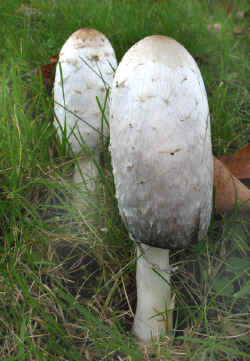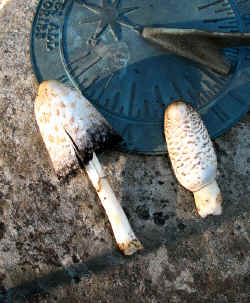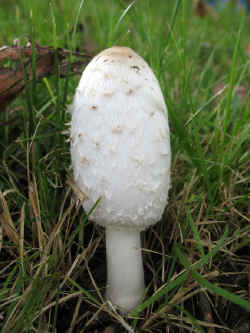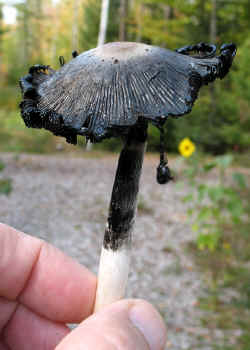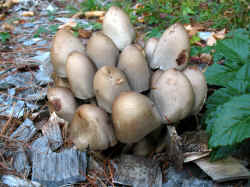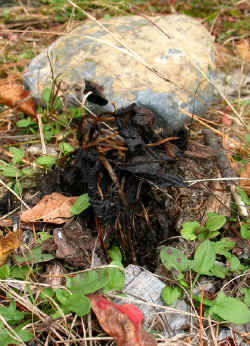|
|
A New England and Eastern Canada Edible and Medicinal Mushroom Resource |
|||
|
Shaggy Mane The Shaggy Mane, also occasionally known as the Lawyers Wig, is a distinctive and easy to recognize mushroom. It's size, shape, and tendency to grow in tight groups make it easy to spot even from considerable distance. Shaggy Mane (Coprinus comatus) has an elongated bullet shaped, shaggy cap, with brownish upturned scales and a straight fairly smooth stem. Cap Shaggy, scaly, whitish,1-2 inches wide, 2-6 inches tall becoming inky and gooey as it expands eventually leaving just the stem. Scales are upturned, whitish tan to reddish brown. Gills (lamellae) White, close, free gills that eventually becoming black and inky. Stem (stipe) Fibrous, hollow, straight white to tannish stem with a partial veil on the lower to middle area. It usually tapers somewhat becoming slight thinner near the top. Flesh White, quite soft and easily broken. Spores Black spores When and where to find them (ecology) These grow in summer and fall in grass, wood chips, rocky, or hard packed soil often appearing shortly after a soaking rain. They may grow singly or scattered but often in large, tightly packed groups. Some years they are very common in city and suburban locations, pastures, lawns, gardens, along driveways, etc. Sometimes they are found in huge quantities presenting quite a dilemma since they require almost immediate preparation. Preparation These should be collected at an early stage before becoming inky. They will turn inky within a few hours after picking and so should be prepared almost immediately. The refrigerator will slow down the process somewhat, but these will not keep. They have a pleasant, subtle flavor that is quite mild so mixing them with strong flavored foods or other mushrooms may cause the flavor to be lost. They will always be good sautéed and served as a stand alone dish. They are good deep fried in tempura also. I don't think they can be dried. Grilling or pickling may be a possibility. They will be satisfactory with eggs, cheese, white sauces, milder vegetables, chicken, fish, etc. Comments Shaggy mane is quite easy to identify but I hesitated to add them because of their very short window of usability and their passing resemblance to Coprinus atramentarius which can cause trouble when consumed with alcohol. Shaggy mane is quite common some years and has a nice but light flavor. Shaggys can be used for dyeing wool, some fabrics, or paper and will yield a gray green color when ammonia is used as a mordant and a bayberry color when cooked in an iron pot. You might have luck with making a slurry for propagating shaggys in your lawn by placing your older inky caps in water for a day or so to capture the spores in solution then pouring the water on your lawn.
|

